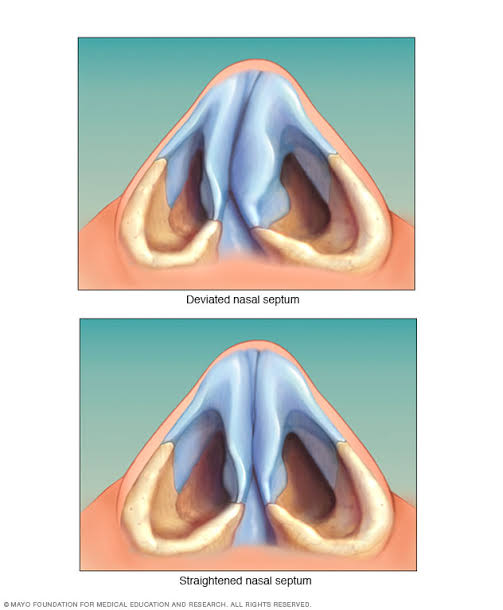Could a Slight Bend Inside Your Nose Be Causing Your Chronic Sinus Pain—And Could Ancient Touch Therapies Fix It?”
- Dr Rakesh VG
- Aug 13
- 3 min read
Updated: Aug 20
By Dr Rakesh Ayureshmi, Ayureshmi Ayurveda Wellness Centre, Kollam, Kerala, India
What if the unseen curve in your nasal septum is the secret tormentor behind your long-lasting sinus misery? Recent interdisciplinary interest hints that non-surgical “touch” therapies—from chiropractic nasal techniques to Ayurvedic marma corrections—might ease chronic sinusitis with surprising grace. In an era when many seek drug-free, holistic relief, revisiting these ancient and adjunctive methods matters now—especially for those weary of medications or hesitant about surgery.
Why the Septum Matters in Sinus Health
The nasal septum—the bone-cartilage partition dividing your nostrils—is deviated in up to 80 % of people, often silently—but when pronounced, it impedes airflow, blocks drainage, and predisposes to chronic sinusitis and headaches . A physically “crooked” septum can create turbulent airflow and stagnation, like a dam slowing a stream—triggering inflammation upstream.
Nasal-Specific Chiropractic Technique: A Tactical Touch
In the mid-1990s, a case report described a 41-year-old woman with chronic sinusitis and sinus headaches who received a combination of spinal manipulation plus “nasal specific technique” and light cranial adjustment, after which she achieved significant symptom relief, sustained over two months . The authors cautioned that this was preliminary and recommended further research. Anecdotal reports from holistic practitioners also describe patients “breathing better, smelling better,” and relief of congestion after nasal adjustments—including in individuals with deviated septum . One patient reported, “I can smell better, taste better, breathe better… openings for each nostril were improving”—highlighting emotional and sensory uplift .
Metaphorically, gentle nasal manipulation may resemble untangling traffic congestion at a toll, restoring smooth flow; a subtle adjustment could ease passage and relieve neural irritation.
Marma Therapy: Ancient Points for Modern Relief
Marma therapy—Ayurveda’s strategic stimulation of vital points—has centuries of traditional use. Contemporary reviews suggest marma may assist in diverse conditions, such as blood-pressure regulation and stroke rehabilitation, indicating potential systemic benefits . One broader review concludes marma helped single-organ and systemic disorders by harmonizing energy pathways—offering a plausible analog to acupressure’s effects in modern physiotherapy .
Case Studies Speak: Stories of Real Change
Ayurvedic Nasya & Nasa Pichu (Bala Taila)
A 2021 case report of a 43-year-old woman with deviated septum and longstanding sinus symptoms used Bala Taila Nasya (nasal instillation of medicated oil) and Nasa Pichu (oil-soaked nasal swab). After a month, symptoms—including nasal obstruction, discharge, headache—resolved, turbinate hypertrophy reduced, and inflammatory markers normalized—with no recurrence in follow-up . The authors emphasized strong patient acceptance and minimal risk.
Viddha Karma + Nasya in a Teenager
In a June 2024 case, a 16-year-old male with deviated septum and chronic sinusitis underwent three sessions of Viddha Karma (therapeutic piercing), combined with Nasya and Ayurvedic medicines. Objective measures (SNOT-22 scores) improved, medication reliance dropped, and surgery was avoided .
These narratives—though limited in scale—highlight transformative potential, especially for those seeking non-surgical and holistic alternatives.
Scientific Limits and the Road Ahead
It must be underscored that mainstream medicine regards chiropractic approaches to non-musculoskeletal conditions—including sinusitis—as lacking robust evidence. Systematic reviews find little support for chiropractic manipulation beyond certain back-pain cases . Similarly, Ayurvedic and marma therapies for deviated septum are grounded primarily in case studies, not large controlled trials—hence, strong scientific conclusions remain premature.
Nonetheless, these methods may offer complementary care, especially for patients avoiding surgery or preferring low-risk, holistic approaches—provided they are delivered by qualified practitioners and undertaken with informed understanding.
Conclusion That Inspires Action or Reflection
In sum, a deviated septum may be a silent architect of chronic sinus suffering—yet ancient and gentle interventions from chiropractic and Ayurveda hint at pathways to breathe freely again, without scalpels or pharmaceuticals. Imagine a world where a tender touch, mindful oil, or precise marma stimulation invites relief—and with it, empowerment and reconnection to one’s own healing capacity.
Are we ready to explore these tactile traditions with curiosity and care? Could the future of sinus health lie not just in surgery—but in the artful harmony of hands and points?
“A simple bend in your nasal septum could be the root of persistent sinus pain—but what if relief lay not in surgery, but in ancient touch therapies? Explore how gentle chiropractic adjustments and Ayurvedic marma points may help you breathe easier—naturally and safely.”





Comments